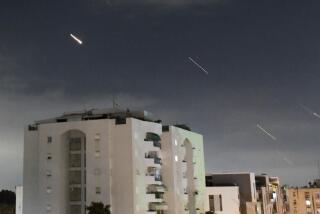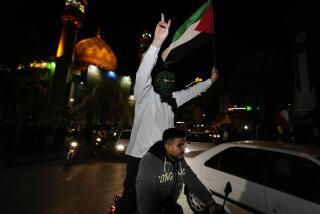Israel shoots down Syrian jet as fighting escalates on edge of Golan Heights
The Israeli military said it shot down a Syrian fighter jet that crossed into Israeli airspace Tuesday amid fierce fighting on the Syrian side of the volatile border.
It was the latest in a series of confrontations that have heightened fears of a dangerous escalation in the region. Tensions between Israel and Syria, technically at war since 1948, have been building over the last month as Syrian government forces, backed by Russian air power, have made sweeping gains against rebel factions in the southwest of the country.
News of the downed warplane came shortly after the Syrian government said its forces had taken back positions near the frontier with the Israeli-occupied Golan Heights that had been under the control of rebels for seven years.
Syrian state media said the jet was targeted as it took part in sorties against fighters loyal to the extremist group Islamic State in the Yarmouk basin, a sliver of land bordering the Golan Heights.
The official Syrian Arab News Agency portrayed the shoot-down, which it said took place over Syrian territory, as evidence of Israeli collusion with the militants — a frequent claim by Syrian officials, and one that Israel rejects.
The Israeli military said the Syrian Sukhoi jet penetrated about a mile into Israeli airspace before two Patriot missiles intercepted it. The plane crashed on the Syrian side of the Golan Heights, Lt. Col. Jonathan Conricus, an Israeli military spokesman, told reporters.
He didn’t know whether there were casualties. The Syrian Observatory for Human Rights, a pro-opposition war monitor based in Britain, reported that one pilot was killed and that the fate of the second pilot was not known.
Conricus said it was unclear whether the Syrian plane had deliberately entered Israeli airspace, but Israeli forces had observed an “irregular amount of aerial activity” on the Syrian side of the border during the course of the day.
Israel issued numerous warnings through different channels and in different languages — including a hotline set up between Israeli and Russian officers to avoid accidentally trading fire over Syria — in a bid to ensure such a breach did not occur, he said.
Israel has avoided taking sides in the war in Syria, now in its eighth year. But it has repeatedly stated that it won’t tolerate any violation of a 1974 agreement that established a demilitarized zone between Israel and Syria — whether by Syrian President Bashar Assad’s government or its allies, Russia and Iran.
Israeli Prime Minister Benjamin Netanyahu called Tuesday’s incident “a gross violation” of the agreement, reached after Israel captured the Golan Heights from Syria in 1967.
“We will not accept any such penetration of, or spillover into, our territory, neither on the ground nor in the air,” Netanyahu said in a video statement.
The country’s military has been on high alert as the fighting in Syria has moved closer to the Golan Heights. On Monday, Israel said it used its new David’s Sling aerial defense system for the first time, firing two missiles at projectiles that were launched in Syria and appeared to be headed toward Israel.
Last week, Syrian opposition factions that previously received support from the United States agreed to surrender their last enclaves in the southwestern provinces of Dara and Quneitra in exchange for safe passage for hundreds of fighters, their families and some civilians to the northern, rebel-held province of Idlib.
Over the weekend, 98 rescuers from the Syria Civil Defense were evacuated with 324 family members through Israel to Jordan after receiving promises of asylum in Canada and Europe. The operation drew angry denunciations from Syria and Russia, which regard the volunteers — also known as the White Helmets for their trademark hard hats — as terrorists because they operate in rebel areas.
Fighting is now concentrated in the Yarmouk basin, the last pocket of territory held by Islamic State in southwestern Syria.
On Tuesday, the Syrian state-run broadcaster Al Ikhbariya reported that Assad’s forces had reached a fence marking the beginning of a United Nations-monitored buffer zone between Syria and Israeli forces in the Golan Heights.
The station broadcast images from a correspondent who said he was standing about 40 yards from the fence. The camera then panned to what the correspondent said was a U.N. post on the other side of the fence and an Israeli post about 400 yards away.
It is the first time that government forces are reported to be in control of positions along the Golan Heights since 2011, when the uprising against Assad began.
Israeli leaders have said they have no objection to Syrian government troops returning to positions they occupied before the war.
“We had no problem with the Assad regime. For 40 years, not a single bullet was fired in the Golan Heights,” Netanyahu told reporters this month.
What worries Israel is whether Assad’s forces will be accompanied by fighters sent by Iran, some of whom are believed to be wearing Syrian uniforms.
“This is a problem we have to be very cautious about, to make sure Iran does not establish its forces along our border,” said retired Brig.Gen. Yossi Kuperwasser, a former head of the Israeli military’s Intelligence Research and Assessment Division.
Israel has carried out dozens of airstrikes against Iranian targets in Syria over the years, many of them said to be weapons shipments destined for the Lebanese militia Hezbollah.
Israel’s Defense Ministry has also announced plans to spend $8.3 billion on missile defense systems over the next 10 years, double previous projections, to contend with what officials describe as a major increase in threats faced by the nation.
Netanyahu reiterated the country’s concerns during a meeting with Russian Foreign Minister Sergei Lavrov and the chief of the Russian military’s general staff, Gen. Valery Gerasimov, in Jerusalem on Monday.
A senior Israeli official said the Russians were offering to enforce a 62-mile buffer zone from which Iranian forces would be barred. The official, who was not authorized to be quoted publicly, said Israel would not tolerate any Iranian buildup in Syria — “not near the border and not beyond the 100-kilometer strip which the Russians are talking about.”
“We said there are weapons with a longer reach than that, and all these forces have to leave Syria,” the official said.
Times staff writer Zavis reported from Beirut and special correspondent Tarnopolsky from Jerusalem. Special correspondent Kareem Chehayeb in Beirut contributed to this report.
UPDATES:
3:50 p.m.: This article was updated with a report that at least one of the pilots of the downed jet was killed and additional details.
10:25 a.m.: This article was updated throughout with staff reporting.
7:20 a.m.: This article was updated with additional details that include the advance of Syrian troops near the Golan Heights.
This article was originally published at 4:50 a.m.
More to Read
Start your day right
Sign up for Essential California for news, features and recommendations from the L.A. Times and beyond in your inbox six days a week.
You may occasionally receive promotional content from the Los Angeles Times.







